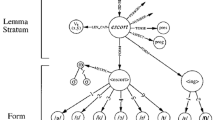Abstract
Two experiments showed that French native speakers rely on sublexical and lexical cues to allocate gender during word recognition. Sublexical cues were based on whether the word ending was typical for a particular gender rather than neutral with regard to gender. Lexical cues were based on whether the associated definite article was informative (for words beginning with a consonant) or uninformative (for words beginning with a vowel). Classification of single nouns and verification of grammatical combinations of indefinite article and noun led to longer times when both sublexical and lexical cues were uninformative compared with when one or both cues were informative. Verification of ungrammatical combinations of indefinite article and noun yielded separate effects of both cues, though only when monitoring for both semantic and syntactic unacceptability in meaningful phrases did people attend to both cues independently. It was argued that people became more cautious in their gender assignments as task requirements became “deeper”. If strategic changes as a function of task demands are incorporated, the results are compatible with connectionist models proposing that gender decisions are computed from strength of past associations of the word and gender-specifying elements.
Similar content being viewed by others
REFERENCES
Badecker, W., Miozzo, M., & Zanuttini, R. (1995). The two-stage model of lexical retrieval: Evidence from a case of anomia with selective preservation of grammatical gender. Cognition, 57, 193-216.
Bates, E., Devescovi, A., Pizzamiglio, L., D'Amico, S., & Hernandez, A. (1995). Gender and lexical access in Italian. Perception & Psychophysics, 57, 847-862.
Beauvillain, C. (1996). The integration of morphological and whole-word information during eye fixations on prefixed and suffixed words. Journal of Memory and Language, 35, 801-820.
Beauvillain, C., & Segui, J. (1992). Representation and processing of morphological information. In R. Frost, & L. Katz (Eds.), Phonology, Orthography, Morphology and Meaning (pp. 377-388). North Holland: Elsevier.
Caramazza, A., & Miozzo, M. (1997). The relation between syntactic and phonological knowledge in lexical access: Evidence from the 'tip-of-the-tongue' phenomenon. Cognition, 64, 309-343.
Content, A., Mousty, P., & Radeau, M. (1990). Brulex: Une base de donn´ees lexicales informatis ´ee pour le franc¸ais ´ecrit et parl´e. L'Ann´ee Psychologique, 90, 551-566.
Desrochers, A., & Brabant, M. (1995). Interaction entre facteurs phonologiques et s´emantiques dans une ´epreuve de cat´egorisation lexicale. Revue Canadienne de Psychologie, 49, 240-262.
Desrochers, A., & Paivio, A. (1990). Le phon'eme initial des noms inanim´es et son effet sur l'identification du genre grammatical. Revue Canadienne de Psychologie, 44, 44-57.
Desrochers, A., Paivio, A., & Desrochers, S. (1989). L'effet de la fr´equence d'usage des noms inanim´es et de la valeur pr´edictive de leur terminasion sur l'identification du genre grammatical. Revue Canadienne de Psychologie, 43, 62-73.
Ferrand, L. (2001). Grammatical gender is also on the tip of French tongues. Current Psychology Letters, 5, 7-20.
Forster, K. I., & Forster, J. C. (1990). Users' Guide to the DMASTR Display System: Laboratory Software for Mental Chronometry. Tucson, AZ: Arizona.
Forster, K. I., & Forster, J. C. (2002). DMDX: A Windows display program with millisecond accuracy. Behavior Research Methods, Instruments, and Computers, 35, 116-124.
Garrett, M. F. (1988). Processes in language production. In F. J. Newmeyer (Ed.), The Cambridge Survey of Linguistics, Vol. III: Biological and Psychological Aspects of Language (pp. 69-96). Cambridge, MA: Harvard University Press.
Garrett, M. F. (1992). Disorders of lexical selection. Cognition, 42, 143-180.
Gollan, T. H., & Frost, R. (2001). Two routes to grammatical gender: Evidence from Hebrew. Journal of Psycholinguistic Research, 30, 627-651.
Henaff Gonon, M., Bruckert, R., & Michel, F. (1989). Lexicalization in an anomic patient. Neuropsychologia, 27, 391-407.
Holmes, V. M., & Dejean de la Batie, B. (1999). Assignment of grammatical gender by native speakers and foreign learners of French. Applied Psycholinguistics, 20, 479-506.
Holmes, V. M., & O'Regan, J. K. (1992). Reading derivationally affixed French words. Language and Cognitive Processes, 7, 163-192.
Levelt, W. J. M. (1989). Speaking: From Intention to Articulation. Cambridge, MA: MIT Press.
Levelt, W. J. M. (2001). Spoken word production: A theory of lexical access. Proceedings of the National Academy of the Sciences of the United States of America, 98, 13464-13471.
MacWhinney, B., Leinbach, J., Taraban, R., & McDonald, J. (1989). Language learning: Cues or rules? Journal of Memory and Language, 28, 255-277.
Miozzo, M., & Caramazza, A. (1997). Retrieval of lexical-syntactic features in tip-of-thetongue states. Journal of Experimental Psychology: Learning, Memory, and Cognition, 23, 1410-1423.
Radeau, M., & van Berkum, J. J. A. (1996). Gender decision. Language and Cognitive Processes, 11, 605-610.
Sokolik, M. E., & Smith, M. E. (1992). Assignment of gender to French nouns in primary and secondary language: A connectionist model. Second Language Research, 8, 39-58.
Taft, M., & Meunier, F. (1998). Lexical representation of gender: A quasi-regular domain. Journal of Psycholinguistic Research, 27, 23-45.
Tucker, G. R., Lambert, W. E., & Rigault, A. (1977). The French Speaker's Skill with Grammatical Gender: An Example of Rule-Governed Behavior. The Hague: Mouton.
Tucker, G. R., Lambert, W. E., Rigault, A., & Sigalowitz, N. (1968). A psychological investigation of French speakers' skill with grammatical gender. Journal of Verbal Learning and Verbal Behavior, 7, 312-316.
Van Turennout, M., Hagoort, P., & Brown, C. M. (1998). Brain activity during speaking: From syntax to phonology in 40 ms. Science, 280, 572-574.
Vigliocco, G., Antonini, T., & Garrett, M. F. (1997). Grammatical gender is on the tip of Italian tongues. Psychological Science, 8, 314-317.
Author information
Authors and Affiliations
Rights and permissions
About this article
Cite this article
Holmes, V.M., Segui, J. Sublexical and Lexical Influences on Gender Assignment in French. J Psycholinguist Res 33, 425–457 (2004). https://doi.org/10.1007/s10936-004-2665-7
Issue Date:
DOI: https://doi.org/10.1007/s10936-004-2665-7




